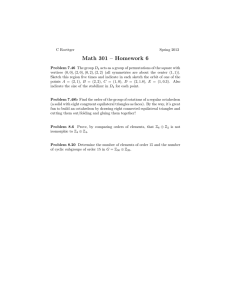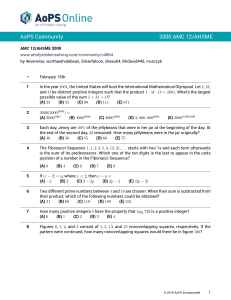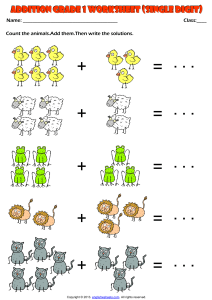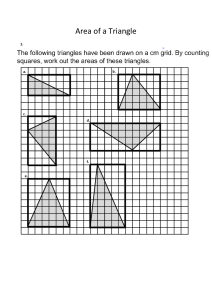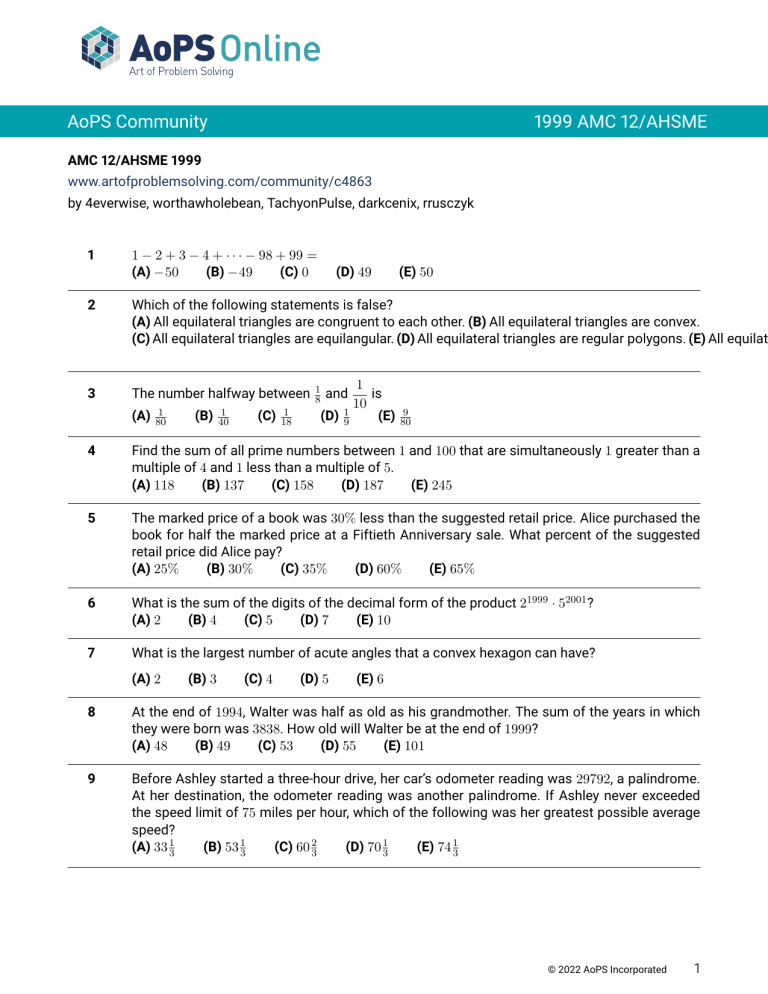
AoPS Community 1999 AMC 12/AHSME AMC 12/AHSME 1999 www.artofproblemsolving.com/community/c4863 by 4everwise, worthawholebean, TachyonPulse, darkcenix, rrusczyk 1 1 − 2 + 3 − 4 + · · · − 98 + 99 = (A) −50 (B) −49 (C) 0 (D) 49 (E) 50 2 Which of the following statements is false? (A) All equilateral triangles are congruent to each other. (B) All equilateral triangles are convex. (C) All equilateral triangles are equilangular. (D) All equilateral triangles are regular polygons. (E) All equilat 3 The number halfway between (A) 1 80 (B) 1 40 (C) 1 18 1 8 1 is 10 1 (D) 9 (E) and 9 80 4 Find the sum of all prime numbers between 1 and 100 that are simultaneously 1 greater than a multiple of 4 and 1 less than a multiple of 5. (A) 118 (B) 137 (C) 158 (D) 187 (E) 245 5 The marked price of a book was 30% less than the suggested retail price. Alice purchased the book for half the marked price at a Fiftieth Anniversary sale. What percent of the suggested retail price did Alice pay? (A) 25% (B) 30% (C) 35% (D) 60% (E) 65% 6 What is the sum of the digits of the decimal form of the product 21999 · 52001 ? (A) 2 (B) 4 (C) 5 (D) 7 (E) 10 7 What is the largest number of acute angles that a convex hexagon can have? (A) 2 (B) 3 (C) 4 (D) 5 (E) 6 8 At the end of 1994, Walter was half as old as his grandmother. The sum of the years in which they were born was 3838. How old will Walter be at the end of 1999? (A) 48 (B) 49 (C) 53 (D) 55 (E) 101 9 Before Ashley started a three-hour drive, her car’s odometer reading was 29792, a palindrome. At her destination, the odometer reading was another palindrome. If Ashley never exceeded the speed limit of 75 miles per hour, which of the following was her greatest possible average speed? (A) 33 13 (B) 53 13 (C) 60 23 (D) 70 13 (E) 74 13 © 2022 AoPS Incorporated 1 AoPS Community 10 1999 AMC 12/AHSME A sealed envelope contains a card with a single digit on it. Three of the following statements are true, and the other is false. I. The digit is 1. II. The digit is not 2. III. The digit is 3. IV. The digit is not 4. Which one of the following must necessarily be correct? (A) I is true. (B) I is false. (C) II is true. (D) III is true. (E) IV is false. 11 The student locker numbers at Olympic High are numbered consecutively beginning with locker number 1. The plastic digits used to number the lockers cost two cents apiece. Thus, it costs two cents to label locker number 9 and four centers to label locker number 10. If it costs $137.94 to label all the lockers, how many lockers are there at the school? (A) 2001 (B) 2010 (C) 2100 (D) 2726 (E) 6897 12 What is the maximum number of points of intersection of the graphs of two different fourth degree polynomial functions y = p(x) and y = q(x), each with leading coefficient 1? (A) 1 (B) 2 (C) 3 (D) 4 (E) 8 13 Define a sequence of real numbers a1 , a2 , a3 , . . . by a1 = 1 and a3n+1 = 99a3n for all n ≥ 1. Then a100 equals (A) 3333 (B) 3399 (C) 9933 (D) 9999 (E) none of these 14 Four girls — Mary, Alina, Tina, and Hanna — sang songs in a concert as trios, with one girl sitting out each time. Hanna sang 7 songs, which was more than any other girl, and Mary sang 4 songs, which was fewer than any other girl. How many songs did these trios sing? (A) 7 (B) 8 (C) 9 (D) 10 (E) 11 15 Let x be a real number such that sec x − tan x = 2. Then sec x + tan x = (A) 0.1 (B) 0.2 (C) 0.3 (D) 0.4 (E) 0.5 16 What is the radius of a circle inscribed in a rhombus with diagonals of length 10 and 24? (A) 4 (B) 58/13 (C) 60/13 (D) 5 (E) 6 17 Let P (x) be a polynomial such that when P (x) is divided by x − 19, the remainder is 99, and when P (x) is divided by x − 99, the remainder is 19. What is the remainder when P (x) is divided by (x − 19)(x − 99)? (A) − x + 80 (B) x + 80 (C) − x + 118 (D) x + 118 (E) 0 © 2022 AoPS Incorporated 2 AoPS Community 1999 AMC 12/AHSME 18 How many zeros does f (x) = cos(log(x))) have on the interval 0 < x < 1? (A) 0 (B) 1 (C) 2 (D) 10 (E) infinitely many 19 Consider all triangles ABC satisfying the following conditions: AB = AC, D is a point on AC for which BD ⊥ AC, AD and CD are integers, and BD2 = 57. Among all such triangles, the smallest possible value of AC is (A) 9 (B) 10 (C) 11 (D) 12 (E) 13 A D B C 20 The sequence a1 , a2 , a3 , . . . satisfies a1 = 19, a9 = 99, and, for all n ≥ 3, an is the arithmetic mean of the first n − 1 terms. Find a2 . (A) 29 (B) 59 (C) 79 (D) 99 (E) 179 21 A circle is circumscribed about a triangle with sides 20, 21, and 29, thus dividing the interior of the circle into four regions. Let A, B, and C be the areas of the non-triangular regions, with C being the largest. Then (A) A + B = C (B) A + B + 210 = C (C) A2 + B 2 = C 2 1 1 1 (D) 20A + 21B = 29C (E) A2 + B 2 = C 2 22 The graphs of y = −|x − a| + b and y = |x − c| + d intersect at points (2, 5) and (8, 3). Find a + c. (A) 7 (B) 8 (C) 10 (D) 13 (E) 18 23 The equiangular convex hexagon ABCDEF has AB = 1, BC = 4, CD = 2, and DE = 4. The area of√the hexagon √ is √ √ 3 (B) 9 3 (C) 16 (D) 39 3 (E) 43 3 (A) 15 2 4 4 24 Six points on a circle are given. Four of the chords joining pairs of the six points are selected at random. What is the probability that the four chords are the sides of a convex quadrilateral? 1 1 1 1 1 (A) 15 (B) 91 (C) 273 (D) 455 (E) 1365 © 2022 AoPS Incorporated 3 AoPS Community 25 1999 AMC 12/AHSME There are unique integers a2 , a3 , a4 , a5 , a6 , a7 such that 5 a2 a3 a4 a5 a6 a7 = + + + + + , 7 2! 3! 4! 5! 6! 7! where 0 ≤ ai < i for i = 2, 3..., 7. Find a2 + a3 + a4 + a5 + a6 + a7 . (A) 8 (B) 9 (C) 10 (D) 11 (E) 12 26 Three non-overlapping regular plane polygons, at least two of which are congruent, all have sides of length 1. The polygons meet at a point A in such a way that the sum of the three interior angles at A is 360◦ . Thus the three polygons form a new polygon with A as an interior point. What is the largest possible perimeter that this polygon can have? (A) 12 (B) 14 (C) 18 (D) 21 (E) 24 27 In triangle ABC, 3 sin A + 4 cos B = 6 and 4 sin B + 3 cos A = 1. Then ∠C in degrees is (A) 30 (B) 60 (C) 90 (D) 120 (E) 150 28 Let x1 , x2 , . . . , xn be a sequence of integers such that (i) −1 ≤ xi ≤ 2, for i = 1, 2, 3, . . . , n; (ii) x1 + x2 + · · · + xn = 19; and (iii) x21 + x22 + · · · + x2n = 99. Let m and M be the minimal and maximal possible values of x31 + x32 + · · · + x3n , respectively. Then M m = (A) 3 (B) 4 (C) 5 (D) 6 (E) 7 29 A tetrahedron with four equilateral triangular faces has a sphere inscribed within it and a sphere circumscribed about it. For each of the four faces, there is a sphere tangent externally to the face at its center and to the circumscribed sphere. A point P is selected at random inside the circumscribed sphere. The probability that P lies inside one of the five small spheres is closest to (A) 0 (B) 0.1 (C) 0.2 (D) 0.3 (E) 0.4 30 The number of ordered pairs of integers (m, n) for which mn ≥ 0 and m3 + n3 + 99mn = 333 is equal to (A) 2 – (B) 3 (C) 33 (D) 35 (E) 99 https://data.artofproblemsolving.com/images/maa_logo.png These problems are copyright © Mathematical Association of America (http://maa.org). © 2022 AoPS Incorporated Art of Problem Solving is an ACS WASC Accredited School. 4

